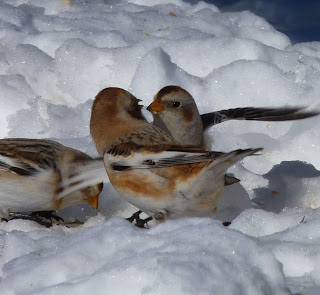 It has been a rough start to winter this year in Connecticut. Snowfall amounts exceeded two feet during a recent snowstorm and yesterday's icy conditions left thousands without power (mine went out while working on this post). One of the bright spots during this tough stretch of winter has been the arrival of large flocks of Snow Buntings, welcome visitors from the arctic region.
It has been a rough start to winter this year in Connecticut. Snowfall amounts exceeded two feet during a recent snowstorm and yesterday's icy conditions left thousands without power (mine went out while working on this post). One of the bright spots during this tough stretch of winter has been the arrival of large flocks of Snow Buntings, welcome visitors from the arctic region. I took these photos of Snow Buntings at Hammonasset on Martin Luther King Day. I sat in my truck mesmerized as large flocks of Snow Bunting repeatedly took flight before settling down to start feeding again. It makes sense to me that some people refer to these birds as snowflakes, because when look like large snowflakes drifting in the wind when they are flying.
I took these photos of Snow Buntings at Hammonasset on Martin Luther King Day. I sat in my truck mesmerized as large flocks of Snow Bunting repeatedly took flight before settling down to start feeding again. It makes sense to me that some people refer to these birds as snowflakes, because when look like large snowflakes drifting in the wind when they are flying. I was given a copy of this 1951 printing of a Chester A. Reed field guide some time back. The cardboard protector on the left shows that it retailed for $3.95 at the time. Here's some of what Chester A. Reed had to say about the Snow Bunting:
I was given a copy of this 1951 printing of a Chester A. Reed field guide some time back. The cardboard protector on the left shows that it retailed for $3.95 at the time. Here's some of what Chester A. Reed had to say about the Snow Bunting: -
"When winter storms sweep across the land these birds blow in like true snowflakes and settle down on wind-blown hillsides and benchlands to fed upon the weed stalks that rise above the snow. They are usually found in large flocks which start up from the ground, as one bird, at the slightest noise."
-
This old field guide can't compete with today's field guides in terms of accuracy and usefulness in identifying birds but I like the descriptions.
-
Here is a quote from one of Theodore Roosevelt's books about Snow Buntings:
-
"One bleak March day,...a flock of snow-buntings came...Every few moments one of them would mount into the air, hovering about with quivering wings and warbling a loud, merry song with some very sweet notes. They were a most welcome little group of guests, and we were sorry when, after loitering around a day or two, they disappeared toward their breeding haunts."
-
Snow Buntings were also mentioned on pages 18 and 61 in this Inuit Mythology book by Evelyn Wolfson . There were also plenty of Horned Lark around. As I was scanning through one large flock of Horned lark, I was able to find a Lapland Longspur, # 74 on my January list.
There were also plenty of Horned Lark around. As I was scanning through one large flock of Horned lark, I was able to find a Lapland Longspur, # 74 on my January list.  I spent some time at Sherwood Island Park in Westport where Common Redpolls had recently been reported. During my visit I saw pretty much what you see in this picture.
I spent some time at Sherwood Island Park in Westport where Common Redpolls had recently been reported. During my visit I saw pretty much what you see in this picture.
 As I was driving along the streets of Stratford, I spotted a Sharp-shinned Hawk, or maybe it spotted me.
As I was driving along the streets of Stratford, I spotted a Sharp-shinned Hawk, or maybe it spotted me.
 There was also this one Killdeer, all by its lonesome. I talked to it for a while before moving on.
There was also this one Killdeer, all by its lonesome. I talked to it for a while before moving on.
 New Haven's Long Wharf was my last stop of the day on Sunday. I added Ruddy Duck, both scaup, and Gadwall. Most of those birds were located near docks along the shore. Just to the right of this photo there is a nature trail where I found a Greater Yellowlegs which flew off while repeating a 3-note flight call. This made it easier to distinguish for a Lesser Yellowlegs which usually makes a 1-2 night flight call.
New Haven's Long Wharf was my last stop of the day on Sunday. I added Ruddy Duck, both scaup, and Gadwall. Most of those birds were located near docks along the shore. Just to the right of this photo there is a nature trail where I found a Greater Yellowlegs which flew off while repeating a 3-note flight call. This made it easier to distinguish for a Lesser Yellowlegs which usually makes a 1-2 night flight call.
click to play: Common Mergansers being harassed by gull
I've continued to plug along with my January despite the weather. My total number of species seen in January is 75 .






